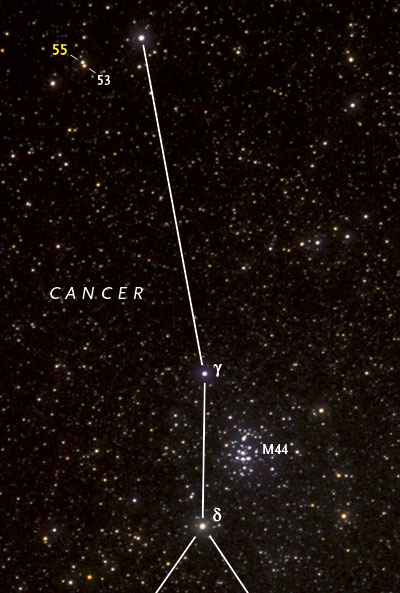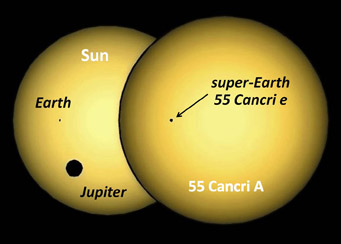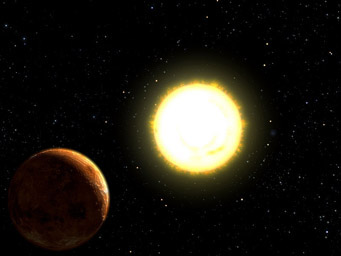On a very dark and clear night far from city lights, you can just make out 55 Cancri as a 6.0-magnitude pinprick in northern Cancer. Shining from 41 light-years away, it’s a main-sequence G8 star a little cooler and dimmer than the Sun. Last Friday it became the brightest star in the sky known to have a planet transiting across its face.

Barely glimmering to the naked eye north of the Beehive Star Cluster, 55 Cancri forms a nice pair with 53 Cancri for binocular observers. How many other ordinary-looking stars hold such secrets?
Akira Fujii
The planet is 55 Cancri e, the closest of the star’s five known worlds. All were discovered by the radial-velocity wobbles that they induce in the star. The wobbling due to planet e was teased out of complex radial-velocity patterns in 2004. Its strength tells that planet e has only 8.6 ± 0.6 Earth masses — a super-Earth.
Astronomers had assumed that 55 Cnc e revolves around the star every 2.8 days. But in late 2010 a paper by Rebekah Dawson, a graduate student at Harvard, and her colleague Dan Fabrycky, now at the University of California in Santa Cruz, analyzed the data differently. They proposed that its orbital period is four times faster: that it circles the star in 17 hours 41 minutes. This would put the planet even closer to the star, increasing the likelihood that it might cross the star’s face as seen from Earth.
Now a team led by Joshua Winn (MIT) confirms that 55 Cnc e indeed transits its sun. The team has observed 17 transits using Canada's MOST (Microvariability and Oscillations of Stars) satellite, the world’s first astroseismology space telescope. MOST studies the internal pulsations of stars by tracking tiny variations in their brightness).
"I'm excited that by calculating the planet's true orbital period, we were able to detect transits, which tell us so much more about it," said Dawson.

Top: All of MOST's brightness observations of 55 Cancri over 14 days, with a few gaps. Bottom: All the transits of planet e overlaid on each other. The red line shows a best fit.
Joshua Winn et al.
In particular, the amount of dimming during the transits tells that the object has a diameter 60% larger than Earth’s. Combined with its mass, this yields an average density of 11 ± 3 grams per cubic centimeter — higher than Earth’s value of 5.5 g/cm³, and implying a large iron core overlain by rock. The surface gravity must be about 3 gs.
Dawson and Fabrycky were inspired to reexamine the wobble data by a paper that MIT astronomer Jack Wisdom circulated informally in 2005, pointing out the possible ambiguity of the orbits in the 55 Cancri system. While radial-velocity tracking has been the mainstay of exoplanet hunters, it has its limitations. Daylight, clouds, and scheduling cause periodic gaps in the observations (which must be done at a large observatory on the ground), creating spurious wobble periods, called aliases, that would not occur if the observations were continuous. Dawson and Fabrycky studied the patterns of these aliases and devised a method to set them apart from true wobble periods. This led to the discovery of the planet’s correct orbit.

Family portraits of two planetary systems: A simulation of the silhouette of planet 55 Cancri e transiting its parent star, compared to Earth and Jupiter transiting our Sun.
J.Rowe (NASA-Ames & SETI Inst. / Jaymie Matthews (UBC)
Planet e not only holds the record for transiting a naked-eye star, but it also has the fastest orbital period of any exoplanet known. It’s even closer to its star than CoRoT-7b (the “Planet from Hell” featured in Sky & Telescope in May 2009) and the similar Kepler-10b (April 2011 issue, page 12). Its star-facing side should be as hot as 4890° F (2970 K), making this also the hottest known world. Being so close to its star it must be tidally locked, so that one side always faces the star and the other always faces away.
All three of these roasted super-Earths have similar high densities and seem to form a class of their own. But since it orbits a star as bright as 6th magnitude, 55 Cancri e holds special promise for future study. “It is very exciting that we have a planet around a bright star,” said Sara Seager, an MIT expert on exoplanets who has contributed to Sky & Telescope.. “We can study it in a way Kepler-10b and CoRoT-7b cannot be observed.” Their stars are magnitudes 11.0 and 11.7, respectively.

An artist's portrayal of the star 55 Cancri and its innermost planet.
University of Texas / NASA / NSF
A super-Earth so close to its star should be stripped of most of its atmosphere due to both heat and furious stellar wind, according to an analysis by Joshua Winn’s team. On the other hand, a paper by Brice-Olivier Demory (MIT) in May 3rd's Astrophysical Journal suggests that maybe this is wrong. The Spitzer Space Telescope’s infrared cameras recorded a single transit in January 2011, and it found the planet’s radius to be 30% larger than that deduced from MOST's observations. This disparity could be caused by thin gases in a very extended outer atmosphere blocking infrared but not visible wavelengths. Seager says that further observations with space telescopes like Spitzer and Hubble will be necessary before coming to any conclusion about an atmosphere.
Could amateurs possibly get in the game? The transits dim 55 Cancri by only 0.0002 magnitude, or two parts in 10,000, much less than even the best amateur photometrists can normally detect. But Greg Laughlin (University of California, Santa Cruz) thinks it could be done nonetheless. “The transit depth is small enough that you would definitely need to observe multiple transits and then stack the data,” he says, “but I think that some of the top amateurs could do it.”
Take that as a challenge.
Shweta Krishnan, an editorial intern at Sky & Telescope this summer, is a recent graduate of the Science and Medical Journalism Program at Boston University. She has a background in clinical medicine and strong interests in astronomy and physical sciences.
 4
4









Comments
Bill Vittitow`
May 4, 2011 at 4:23 pm
Could we perhaps assume that the other planets are in the same orbital plane and thereby get small bounds on their masses?
You must be logged in to post a comment.
Robert Hunter
May 5, 2011 at 11:25 am
I'm having a bit of difficulty understanding the comment about the density of 11 gm/cc ????? Does iron compress when under great pressure? Iron is normally about 8 gm/cc.
I don't think Earth's internal pressures are sufficient to compress it. What would the pressure within this planet need to be?
You must be logged in to post a comment.
Rod
May 6, 2011 at 7:51 pm
These exoplanets are getting most interesting. The URL http://exoplanet.eu/catalog.php contains a good table. Currently 128 transiting exoplanets are found here (includes 55 Cnc e). I did some stats. 74 have mean densities <=1 g cm^-3 and semi-major axis <= 0.1 AU. We see very close orbiting exoplanets with very low mean densities as well as some with high mean densities like 55 Cnc e. I am glad S&T reported some additional measurement issues for 55 Cnc e in this report.
You must be logged in to post a comment.
Michael C. Emmert
May 10, 2011 at 11:19 am
I knew there would be such a class of planets. This is the end result of the chaos found in most systems (but not, thankfully, in our own). I did a Gravity Simulator run on our own solar system and programmed in 10 Jupiter masses on our regular gas giants. The system fell apart immediatly and all the planets assumed highly eccentric orbits. This resulted in Saturn coming within less than an A.U. of the Sun (Saturn? That's what the results were :?)
If a planet gets within 0.04 - 0.05 A.U. of it's star, the tides on the planet are huge. This heats the planet drastically and the outer atmosphere evaporates. So the loss of atmosphere is NOT from radiant energy from the star but rather from tides. The energy released will eventually result in a circular orbit at what was once periaster.
Look at the Kepler results and you will see this class of planets plainly displayed.
You must be logged in to post a comment.
You must be logged in to post a comment.